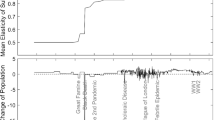Abstract
Easterlin believed that there were two features associated with the birth cycles he observed: the cycles were related to the labor market, and they might be self-generating. This paper tries to set up a model that contains both of these two features. We suppose that the welfare of various age-specific cohorts are determined by their respective marginal productivity, and that the underlying technology which puts together labor force of various age-specific cohorts can be characterized by a general production function. Under these weak assumptions, we show that the well-analyzed cohort and period models along the lines of Lee (1974) are restricted versions of our general setting. Given that both the cohort model and the period model were rejected by statistical tests, we adopt the coefficient values obtained from the estimation of the unrestricted version to perform the bifurcation analysis. We go beyond the previous study which focused upon the possible existence of limit cycles, and show that the U. S. fertility limit cycle solution is unstable. Therefore the population trajectory will never converge to that limit cycle.
Similar content being viewed by others
References
Berger MC (1983) Changes in labor force composition and male earnings: A production approach. J Human Resources 17:177–196
Berndt ER (1991) The practice of econometrics: Classic and contemporary. Addison-Wesley, New York
Chesnais J-C (1992) The demographic transition: Stages, patterns, and economic implications. Oxford University Press, Oxford
Chu CYC (1990) An existence theorem on the stationary state of income distribution and population growth. Int Econ Rev 31:171–185
Chu CYC, Koo H-W (1990) Intergenerational income-group mobility and differential fertility. Am Econ Rev 80:1125–1138
Connelly R (1986) A framework for analyzing the impact of cohort size on education and labor earning. J Human Resources 21:543–562
Cowgill DO (1949) The theory of population growth cycles. Am J Sociol 55:163–170
Cushing JM (1978) Nontrivial periodic solutions of some Volterra integral equations (Lect Notes Math, vol 737, pp 50–66). Springer, Berlin Heidelberg New York
Davison R, MacKinnon JG (1993) Estimation and inference in econometrics. Oxford University Press, New York
Day RH, Kim K-H, Macunovich D (1989) Complex demoeconomic dynamics. J Popul Econ 2:139–159
Diewert WE (1974) Applications of duality theory. In: Intriligator M, Kendrick D (eds) Frontiers of quantitative economics, vol 2. North-Holland, Amsterdam
Easterlin RA (1961) The American baby boom in historical perspective. Am Econ Rev 51:860–911
Easterlin RA (1980) Birth and fortune, 2nd edn. University of Chicago Press, Chicago
Feichtinger G, Dockner EJ (1990) Capital accumulation, endogenous population growth, and Easterlin cycles. J Popul Econ 3:73–87
Feichtinger G, Sorger G (1989) Self-generated fertility waves in a non-linear continuous overlapping generations model. J Popul Econ 2:267–280
Frauenthal JC (1975) A dynamical model for human population growth. Theoret Popul Biol 8:64–73
Frauenthal JC, Swick KE (1983) Limit cycle oscillations of the human population. Demography 20:285–298
Freeman R (1979) The effect of demographic factors on age-earnings profiles. J Human Resources 14:289–318
Golubitsky M, Schaeffer DG (1985) Singularities and groups in bifurcation theory, vol I. Springer, Berlin Heidelberg New York
Judge GG et al (1988) Introduction to the theory and practice of econometrics, 2nd edn. John Wiley & Sons, New York
Keyfitz N (1972) Population waves. In: Greville THE (ed) Population dynamics. Academic Press, New York
Lau LJ (1986) Functional forms in econometric model building. In: Griliches Z, Intriligator MD (s) Handbook of econometrics, vol 3. North-Holland, Amsterdam
Lee RD (1974) The formal dynamics of controlled populations and the echo, the, boom and the bust. Demography 11:563–585
Lee RD (1975) Natural fertility, population cycles and the spectral analysis of births and marriages. J Am Statist Assoc 70:295–304
Lee RD (1976) Demographic forecasting and the Easterlin hypothesis. Popul Dev Rev 2:459–468
Lee RD (1978) Causes and consequences of age structure fluctuations: The Easterlin hypothesis. Proceedings of Conference on Economic and Demographic Change, Issues for the 1980s held at Helsinki 1:405–418
Lee RD (1987) Population dynamics of humans and other animals. Demography 24:443–465
Lorenz HW (1989) Nonlinear dynamical economics and chaotic motion. Springer, Berlin Heidelberg New York
Pesaran MH, Deaton AS (1978) Testing non-nested nonlinear regression models. Econometrica 46:677–694
Samuelson P (1976) An economist's non-linear model of self-generated fertility waves. Popul Studies 30:243–248
Swick KE (1981 a) Stability and bifurcation in age-dependent population dynamics. Theoret Popul Biol 40:80–100
Swick KE (1981 b) A nonlinear model for human population dynamics. SIAM J Appl Math 40:266–278
Taljapurkar S (1987) Cycles in nonlinear age-structured models I: Renewal equations. Theoret Popul Biol 32:26–41
Varian HR (1984) Microeconomic analysis, 2nd edn. Norton, New York
Wachter KW (1991) Elusive cycles: Are there dynamically possible Lee-Easterlin models for U.S. births? Popul Studies 45:109–135
Wachter KW, Lee RD (1989) U.S. birth and limit cycle models. Demography 26:99–115
Ward MD, Buth WP (1980) Completed fertility and its timing. J Polit Econ 88:917–940
Author information
Authors and Affiliations
Additional information
We thank Professors Kenneth Wachter, Shripad Tuljapurkar, and two anonymous referees for their valuable help, comments and suggestions.
Rights and permissions
About this article
Cite this article
Cyrus Chu, C.Y., Lu, HC. Toward a general analysis of endogenous Easterlin cycles. J Popul Econ 8, 35–57 (1995). https://doi.org/10.1007/BF00172037
Received:
Accepted:
Issue Date:
DOI: https://doi.org/10.1007/BF00172037




